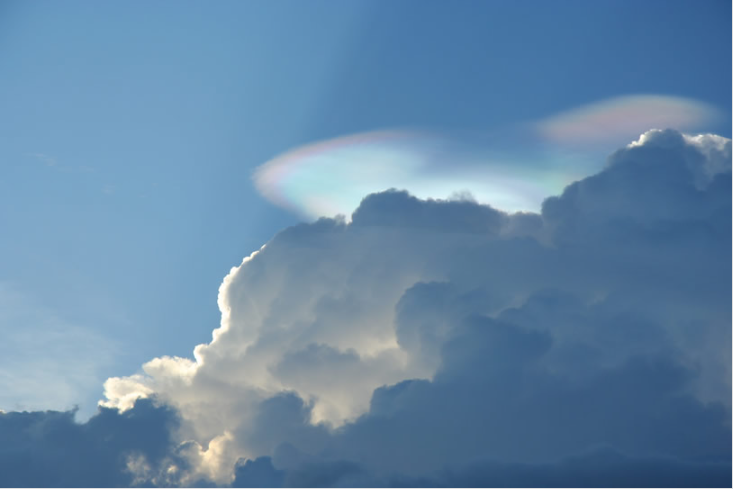Pileus Cloud Iridescence, Singapore
Pileus Cloud Iridescence: A Delicate Display of Colors in Singapore's Sky
Have you ever looked up at the sky and been captivated by the vibrant colors that seem to dance among the clouds? One phenomenon that showcases the beauty of nature's palette is pileus cloud iridescence. In this article, we will delve into the mesmerizing world of pileus clouds and explore the fascinating science behind their iridescent hues.
The Enchanting Formation of Pileus Clouds
Pileus clouds, also known as cap clouds, form when a layer of moist air is forced upwards by towering cumulus clouds beneath it. As this moist air rises, it encounters cooler temperatures and condenses into droplets. These droplets, which have similar sizes, create a thin veil-like layer on top of the cumulus cloud, giving birth to the delicate pileus cloud formation.
Unveiling the Delicacy of Colors
One of the most captivating aspects of pileus clouds is their ability to exhibit iridescence. Iridescence refers to the phenomenon where colors appear to change as the viewing angle or lighting conditions vary. In the case of pileus clouds, this optical effect is a result of the interaction between light and the tiny water droplets that compose the cloud.
When sunlight passes through these droplets, it undergoes a process called diffraction, where the light waves bend and scatter. This bending of light causes interference, resulting in the separation of colors and the creation of a stunning display of iridescent hues. The delicate nature of pileus clouds allows for a more pronounced iridescence, amplifying the enchanting effect.
The Role of Droplet Size in Iridescence
The size of the water droplets within pileus clouds plays a crucial role in determining the intensity and visibility of iridescence. For iridescence to occur, the droplets must be of a similar size, allowing for consistent diffraction and interference of light. When the droplets are too large or too small, the iridescent effect becomes less pronounced or may not occur at all.
Exploring the Spectral Colors
The colors observed in pileus cloud iridescence span a range of hues, from vivid blues and greens to soft pinks and purples. These colors arise due to the separation of light waves into their constituent colors during diffraction. The specific colors observed depend on factors such as the size of the droplets, the angle of sunlight, and the observer's position.
Capturing the Beauty Through Photography
Photographers have the unique ability to capture the ephemeral beauty of pileus cloud iridescence. Through their lenses, they freeze these fleeting moments, allowing us to marvel at the delicate colors and intricate patterns that grace the sky. Images, such as the one captured by Wong Chee Ming in Singapore, serve as a testament to the captivating nature of pileus cloud iridescence.
The Rarity of Pileus Cloud Iridescence
While pileus clouds themselves are not uncommon, witnessing their iridescence is a rare occurrence. Several factors need to align perfectly for this phenomenon to manifest itself. The right combination of moisture, temperature, and cloud structure must come together to create the ideal conditions for pileus cloud iridescence. Therefore, those fortunate enough to witness this ethereal display should consider themselves truly lucky.
Appreciating Nature's Artistry
Pileus cloud iridescence serves as a reminder of the immense beauty and complexity that surrounds us in the natural world. It is a testament to the intricate interplay between light and matter, showcasing nature's artistry in all its glory. So, the next time you find yourself gazing at the sky, take a moment to appreciate the delicate colors that adorn the clouds and marvel at the wonders that lie just above our heads.
In conclusion, pileus cloud iridescence is a breathtaking phenomenon that enchants observers with its delicate display of colors. From the enchanting formation of pileus clouds to the role of droplet size in iridescence, there is much to explore and appreciate about this natural spectacle. So, keep your eyes to the sky and be ready to witness the awe-inspiring beauty of pileus cloud iridescence whenever nature decides to grace us with its presence.

Iridescence in Pileus Cloud imaged by Wong Chee Ming in Singapore. This unenhanced image shows well the delicacy of the colours.
Pileus forms when a layer of moist air is forced upwards by cumulus cloud towering beneath it. The freshly formed pileus droplets have similar sizes and iridesce well.
Image ©Wong Chee Ming.
Note: this article has been automatically converted from the old site and may not appear as intended. You can find the original article here.
Reference Atmospheric Optics
If you use any of the definitions, information, or data presented on Atmospheric Optics, please copy the link or reference below to properly credit us as the reference source. Thank you!
-
<a href="https://atoptics.co.uk/blog/pileus-cloud-iridescence-singapore/">Pileus Cloud Iridescence, Singapore </a>
-
"Pileus Cloud Iridescence, Singapore ". Atmospheric Optics. Accessed on November 19, 2024. https://atoptics.co.uk/blog/pileus-cloud-iridescence-singapore/.
-
"Pileus Cloud Iridescence, Singapore ". Atmospheric Optics, https://atoptics.co.uk/blog/pileus-cloud-iridescence-singapore/. Accessed 19 November, 2024
-
Pileus Cloud Iridescence, Singapore . Atmospheric Optics. Retrieved from https://atoptics.co.uk/blog/pileus-cloud-iridescence-singapore/.